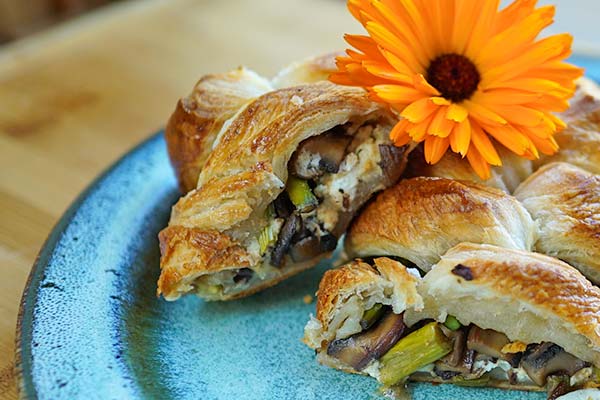Written by Lindsey Smith. Published in August 2018.
Not only is canning a great way to use up all that extra summer produce, but it’s a ton of fun!
Just ask our Chef. Jessica, the breakfast chef at the Harrison House Suites and Tucker House Inn. She loves canning and has a real knack for it, too. Every week during the summer season, deliveries arrive filling our coolers with fresh plums, blackberries, cherries, nectarines, apricots, raspberries, strawberries, blueberries — to name a few. Our summertime guests at the San Juan Island Inn Collection love enjoying new varieties each morning with their breakfast. But what about the rest of the year when produce isn’t quite as plentiful? Well, that’s when we are thankful for canning. Try it for yourself this season and you will be, too!
Jelly vs. Jam
As we dive into the basics of canning, let’s talk about some different types:
Jam: the fruit comes in the form of fruit pulp or crushed fruit (and is less stiff than jelly as a result)
Jelly: the fruit comes in the form of fruit juice, no fruit pulp found
Preserve: the fruit comes in the form of chunks in a syrup or a jam, sometimes with other fruit or ingredients in the mix, as well
In this lesson, Chef Jessica is making jam from local blackberries and a preserve from local golden plums. But today, we are going to mostly focus on the blackberry jam.
1. Pick your Fruit
 If you don’t have a blackberry bush in your backyard, head to a local farmers market or a “u-pick” farm. The grocery store is always an option, too. Find yourself a few lbs of good-looking blackberries and you’ll be underway. You will also need a large amount of sugar. Some optional ingredients: “Fruit Fresh” browning protector is helpful if you are using a fruit that browns easily – we did not use this for blackberry jam. “Sure Jell” fruit pectin is also commonly used in jam making as it produces a higher yield and faster processing time. We wanted to simply use fruit, sugar and water so we omitted both of those steps.
If you don’t have a blackberry bush in your backyard, head to a local farmers market or a “u-pick” farm. The grocery store is always an option, too. Find yourself a few lbs of good-looking blackberries and you’ll be underway. You will also need a large amount of sugar. Some optional ingredients: “Fruit Fresh” browning protector is helpful if you are using a fruit that browns easily – we did not use this for blackberry jam. “Sure Jell” fruit pectin is also commonly used in jam making as it produces a higher yield and faster processing time. We wanted to simply use fruit, sugar and water so we omitted both of those steps.
2. Start Slicing
 This step only applies if you are doing a jam with a non-berry fruit such as golden plums featured in the photo. It helps when they are halved or quartered first for easier processing.
This step only applies if you are doing a jam with a non-berry fruit such as golden plums featured in the photo. It helps when they are halved or quartered first for easier processing.
3. Mix it Up & Heat it Up

 For our recipe, we used the measurements found on the National Center for Home Food Preservation website. Here is when you decide if you are going to use added pectin or a fruit browning protector in your mixture along with your fruit of choice and sugar.
For our recipe, we used the measurements found on the National Center for Home Food Preservation website. Here is when you decide if you are going to use added pectin or a fruit browning protector in your mixture along with your fruit of choice and sugar.
Once mixed in a pot, heat on the stove and until it starts to break down. Mash with a wooden spoon during this process to get the consistency of a thick, pulpy juice. This process can take awhile, it took us about an hour for our batch with 8 quarts of berries.


4. Heat up those Lids
 Heat the mason jar lids in a pot of warm water while the fruit is still processing on the stove. This will help create the seal when your begin jarring the product.
Heat the mason jar lids in a pot of warm water while the fruit is still processing on the stove. This will help create the seal when your begin jarring the product.
5. Putting it all Together
 Scoop the contents into sterilized jars and secure the lids. (To sterilize empty jars, put them right side up on the rack in a boiling-water canner. Fill the canner and jars with hot (not boiling) water to 1 inch above the tops of the jars.) Leave a 1/4-1/2 inch space in the jar at the top after pouring in the fruit. After the process is finished and this air pocket cools, it will help create a better seal.
Scoop the contents into sterilized jars and secure the lids. (To sterilize empty jars, put them right side up on the rack in a boiling-water canner. Fill the canner and jars with hot (not boiling) water to 1 inch above the tops of the jars.) Leave a 1/4-1/2 inch space in the jar at the top after pouring in the fruit. After the process is finished and this air pocket cools, it will help create a better seal.
6. Bring to a Boil
 Use your jar lifter tongs to carefully place the jars in a large pot of warm water. We placed a circular rack on the bottom to keep the jars flat. Cover and bring to a boil. Use the NCHFP website again to see how long you need to boil to kill any bacteria based on your geographic location and distance from sea level. Once they are done boiling, simply let them cool and put them in a box in your pantry, as they have a very long-lasting shelf life! As they cool you will hear the lids pop down to create the seal. It’s the jars’ way of telling you they’re ready for storage. If the jars do not seal after being cool and the lids pop up and down when depressed you have an improper seal. These jars shouldn’t be stored. Refrigerate those jars and use the jam immediately. Without a proper seal the fruit is not safe to enjoy and may become contaminated.
Use your jar lifter tongs to carefully place the jars in a large pot of warm water. We placed a circular rack on the bottom to keep the jars flat. Cover and bring to a boil. Use the NCHFP website again to see how long you need to boil to kill any bacteria based on your geographic location and distance from sea level. Once they are done boiling, simply let them cool and put them in a box in your pantry, as they have a very long-lasting shelf life! As they cool you will hear the lids pop down to create the seal. It’s the jars’ way of telling you they’re ready for storage. If the jars do not seal after being cool and the lids pop up and down when depressed you have an improper seal. These jars shouldn’t be stored. Refrigerate those jars and use the jam immediately. Without a proper seal the fruit is not safe to enjoy and may become contaminated.
7. Enjoy!
 We waited about 24 hours before popping open our first jar. But we often wait years! No matter how long you wait, we’re sure you will enjoy that final product.
We waited about 24 hours before popping open our first jar. But we often wait years! No matter how long you wait, we’re sure you will enjoy that final product.
And hey, if you’re not keen on canning, just book your stay with us at the San Juan Island Inn Collection and we will serve you some of our delicious jams or chutneys with your breakfast.










